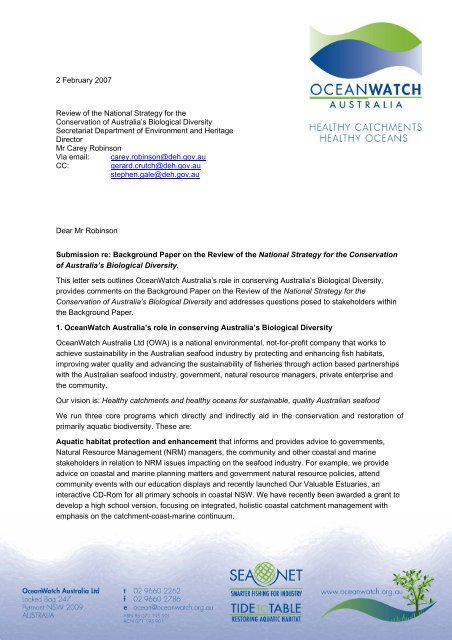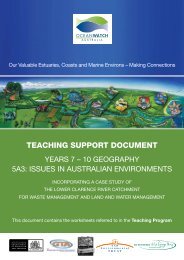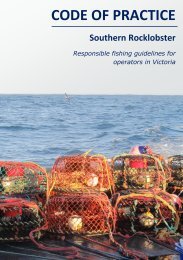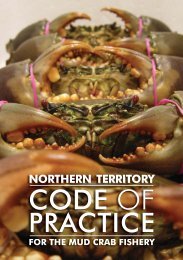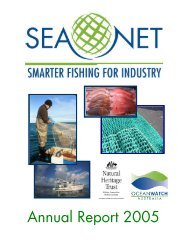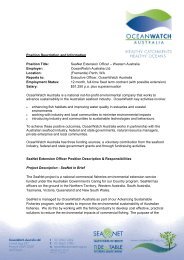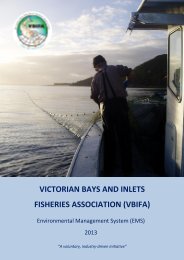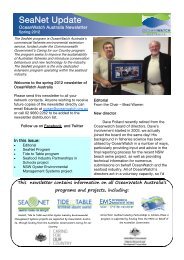OWA letterhead template - OceanWatch Australia
OWA letterhead template - OceanWatch Australia
OWA letterhead template - OceanWatch Australia
You also want an ePaper? Increase the reach of your titles
YUMPU automatically turns print PDFs into web optimized ePapers that Google loves.
2 February 2007<br />
Review of the National Strategy for the<br />
Conservation of <strong>Australia</strong>’s Biological Diversity<br />
Secretariat Department of Environment and Heritage<br />
Director<br />
Mr Carey Robinson<br />
Via email:<br />
CC:<br />
carey.robinson@deh.gov.au<br />
gerard.crutch@deh.gov.au<br />
stephen.gale@deh.gov.au<br />
Dear Mr Robinson<br />
Submission re: Background Paper on the Review of the National Strategy for the Conservation<br />
of <strong>Australia</strong>’s Biological Diversity.<br />
This letter sets outlines <strong>OceanWatch</strong> <strong>Australia</strong>’s role in conserving <strong>Australia</strong>’s Biological Diversity,<br />
provides comments on the Background Paper on the Review of the National Strategy for the<br />
Conservation of <strong>Australia</strong>’s Biological Diversity and addresses questions posed to stakeholders within<br />
the Background Paper.<br />
1. <strong>OceanWatch</strong> <strong>Australia</strong>’s role in conserving <strong>Australia</strong>’s Biological Diversity<br />
<strong>OceanWatch</strong> <strong>Australia</strong> Ltd (<strong>OWA</strong>) is a national environmental, not-for-profit company that works to<br />
achieve sustainability in the <strong>Australia</strong>n seafood industry by protecting and enhancing fish habitats,<br />
improving water quality and advancing the sustainability of fisheries through action based partnerships<br />
with the <strong>Australia</strong>n seafood industry, government, natural resource managers, private enterprise and<br />
the community.<br />
Our vision is: Healthy catchments and healthy oceans for sustainable, quality <strong>Australia</strong>n seafood<br />
We run three core programs which directly and indirectly aid in the conservation and restoration of<br />
primarily aquatic biodiversity. These are:<br />
Aquatic habitat protection and enhancement that informs and provides advice to governments,<br />
Natural Resource Management (NRM) managers, the community and other coastal and marine<br />
stakeholders in relation to NRM issues impacting on the seafood industry. For example, we provide<br />
advice on coastal and marine planning matters and government natural resource policies, attend<br />
community events with our education displays and recently launched Our Valuable Estuaries, an<br />
interactive CD-Rom for all primary schools in coastal NSW. We have recently been awarded a grant to<br />
develop a high school version, focusing on integrated, holistic coastal catchment management with<br />
emphasis on the catchment-coast-marine continuum.
Aquatic habitat rehabilitation that undertakes on-ground works to rehabilitate and enhance priority<br />
fish habitat areas across <strong>Australia</strong>. Our flagship project within this program, is known as Tide to Table<br />
and is funded under the National Landcare Program. Partnerships are formed with terrestrial and<br />
marine based primary producers, landholders, regional Natural Resource Management (NRM) bodies,<br />
government and community based Landcare and Bushcare groups for the purpose of improving<br />
productive fish habitats and thus enhancing fisheries production. This program is currently operating in<br />
3 regions of coastal NSW and will commence in March in the Burnett-Mary Region in QLD.<br />
Advancing sustainable fisheries that improves the sustainability of <strong>Australia</strong>n fisheries through<br />
working with professional and recreational fishers and others to develop cost effective and practical<br />
solutions to reducing the environmental impacts of professional and recreational fishing. This program<br />
is delivered predominately to the professional sector across <strong>Australia</strong> through a national environmental<br />
extension service called SeaNet. SeaNet provides information and advice on reducing environmental<br />
impacts, and works directly with industry, managers and researchers to develop and implement<br />
improved fishing gear, technology and methods. It aims to minimise the catch of non-target species<br />
(bycatch) and encourage environmental best practice for industry.<br />
<strong>OceanWatch</strong> <strong>Australia</strong> also works with the recreational sector to address environmental issues. We<br />
recently commenced a project called the TAngler Bin project which works towards addressing the issue<br />
of death and injury to wildlife that is caused by lost and littered monofilament fishing line.<br />
For more information see www.oceanwatch.org.au or contact us on 02 9660 2262.<br />
2 Specific comments on the Background Paper<br />
2.1 Incentives and community and industry engagement (Section 4.3 and 4.4 of the Background<br />
Paper)<br />
<strong>OWA</strong> is pleased to see that the Strategy recognises “fisheries” in the list of stakeholders identified<br />
which are to be “supported and encouraged in their efforts to manage <strong>Australia</strong>’s natural resources for<br />
the benefit of all <strong>Australia</strong>ns now and into the future.”<br />
However to date, there have been few initiatives/ incentives that focus on marine primary producers i.e.<br />
the professional fishing industry. Those listed within the Background/Strategy have a distinct terrestrial<br />
focus The Decade of Landcare Program (1989) and Bushcare; National Market Based Instruments<br />
Pilot Program, the Biodiversity Hotspots Program, the Forest Conservation Fund, the Victorian Bush<br />
Tender, and the NSW Property Vegetation Plan.”<br />
Considerable inequality exists between incentives and support that is provided to terrestrial primary<br />
producers i.e. agriculture and aquatic/marine primary producers i.e. fishing and marine based<br />
aquaculture industries. Both are primary industries, however governments in some instances still seem<br />
to struggle with this concept. This situation is reflected by the number of Commonwealth funded<br />
officers dedicated to assist farmers with environmental initiatives i.e. there are over 1,000 officers;<br />
compared to 8 Commonwealth (NHT) funded SeaNet Officers that provide extension and support to the<br />
professional fishing industry. The professional fishing industry constantly faces challenges to improve<br />
its environmental credentials/ performance, through regulatory approaches as well as voluntary,<br />
however are provided with little financial assistance to do so. For example, AFMA recently announced<br />
its goal to reduce bycatch by 50% by 2008 and ensure zero discards, however there is little additional<br />
support or financial assistance provided for fishers to achieve these mandatory goals e.g. trialing and<br />
adoption of BMPs such as cutting edge bycatch reduction devices that may involve replacing all fishing
gear. Fishers will need to bear the costs of whatever changes are identified as necessary. Farmers on<br />
the other hand are given grants and incentives to assist them to adopt more sustainable practices and<br />
to protect green zones on their properties. If the <strong>Australia</strong>n Government is serious about<br />
implementing <strong>Australia</strong>’s Oceans Policy then it needs to engage in a more constructive way<br />
with marine based primary producers and assist them in the delivery of the outcomes being<br />
sought, as it does for land based primary producers. A well resourced and structured marine<br />
version of Landcare is required and the revised Strategy should reflect this need.<br />
One of the few such incentive programs offered to the professional fishing industry in the<br />
Environmental Management System (EMS) Incentives Program. This Program was developed by<br />
DAFF and is managed by Centrelink. It allows fishers operating under an EMS to receive financial<br />
assistance (50% in kind support up to $3,000) to address actions identified in their EMS that will<br />
improve the sustainability of their operations. So far that has been predominately used to assist<br />
professional fishers to upgrade from older 2-stroke motors to those with an improved emission<br />
standard to reduce emissions entering the waterways and lessen the use of fossil fuels. Our NSW<br />
SeaNet Officer has also been successful, although with some difficulties, in accessing funding to assist<br />
oyster farmers offset the cost associated with replacing old infrastructure with modern materials such<br />
as polyurethane trays and materials used in long-line and floating bag cultivation.<br />
There is little evidence of this situation changing, with future stewardship programs aimed at farmers.<br />
None of these programs propose to involve fishers. The revised National Strategy needs to address<br />
this obvious gap and provide greater support to the professional fishing industry.<br />
Furthermore, financial incentives provided to landholders need to incorporate incentives to conserve<br />
aquatic biodiversity. One of the few Commonwealth NLP funded projects that does focus on improving<br />
aquatic biodiversity though restoration and rehabilitation of priority fish habitat areas is <strong>OceanWatch</strong><br />
<strong>Australia</strong>’s NLP funded project called “Tide to Table”. Tide to Table integrates the catchment based<br />
NRM priorities of the seafood industry into the NRM process enabling fishers to take an active part in<br />
the prioritisation of pollution issues and land management actions that directly affect fisheries<br />
productivity and therefore their industry. Often these issues originate on private lands, seemingly far<br />
removed from the area of operation of the fishery. Tide to Table fosters partnerships between<br />
landholders, in particular land based primary producers and fishers, to undertake on ground actions<br />
that address these priorities. Tide to Table also brings together the actions of local Landcare and<br />
Bushcare groups with fish habitat priorities and invites these individuals to consider the land/water<br />
interface from another perspective.<br />
This type of project is an example of where the <strong>Australia</strong>n Government needs to focus in the<br />
immediate future to ensure coastal and marine priorities can been actioned through integrated<br />
partnerships and the capacity of landholders and the community increased to understand the<br />
linkages between the catchment and the marine environment. The revised Strategy should<br />
incorporate this type of approach.<br />
It is imperative that the revised Strategy also give priority to the need to establish market based<br />
incentive schemes for the aquatic environment. To date the focus has been on terrestrial based<br />
systems such as Biodiversity Banking being introduced in NSW. With the scale of coastal development<br />
underway across <strong>Australia</strong> and the pressure the coastal/marine environment is under with respect to an<br />
increasing coastal population, we can no longer ignore the need to consider the impacts we are having<br />
on the coastal aquatic and marine environments, in particular the cumulative impacts to our estuaries
and inshore marine environments. The revised Strategy must discuss and recommend the need<br />
to establish market based models that allow consideration of the aquatic realm and factor in<br />
cumulative impacts. For too long in <strong>Australia</strong>, developers, planning agencies and water authorities<br />
have had very limited conditions placed on them with respect to considering and managing for aquatic<br />
impacts. There are so many unknowns with respect to the impacts many developments have on<br />
aquatic ecosystems as monitoring is not required and research does not focus on these areas. With<br />
the potential impacts from climate change on their way, the urgency becomes so much more important.<br />
2.2 Institutional and capacity building issues (Section 5 in the Background Paper)<br />
<strong>OceanWatch</strong> <strong>Australia</strong> agrees with the Background Paper statement that an “increased level of<br />
industry engagement” is required particularly relating to the professional fishing industry. This is<br />
paramount, given the paucity of information that exists relating to the marine environment and the<br />
detailed knowledge that fishers have pertaining to the aquatic/marine environment. It is critical that<br />
NRM managers improve engagement with this industry in order to harness such knowledge.<br />
NRM managers often experience difficulty in getting fishers to attend meetings etc. It must be<br />
acknowledged that a day spent in a meeting for fishers, is a day that is not spent fishing i.e. a days lost<br />
income, whereas, government officials are paid regardless and farmers crops still grow. Consideration<br />
should be given to payments for fishers to attend meetings or alternatively meetings should be<br />
arranged at a convenient time for fishers. This will contribute towards improved engagement of<br />
industry. The revised Strategy should reflect the need to implement more effective systems to<br />
engage with marine based primary producers such as fishers.<br />
There is considerable scope to utlise <strong>OceanWatch</strong> <strong>Australia</strong> to assist in arranging/ facilitating such<br />
meetings as we are in a unique position having established strong relationships with the industry over<br />
the last 17 years. <strong>OceanWatch</strong> <strong>Australia</strong> can utilise its SeaNet Officers who have developed very close<br />
working relationships with industry.<br />
2.3 Spread of invasive species (Section 7.2 in the Background Paper)<br />
More attention is needed towards invasive aquatic estuarine and marine species. This is reflected in<br />
the Background Paper which states “The cost to <strong>Australia</strong> imposed by invasive marine species has not<br />
been quantified; however there is a significant negative impact on local biodiversity and<br />
estuarine/marine industries such as aquaculture. There are approximately 150-250 known introduced<br />
marine species in <strong>Australia</strong>.”<br />
The National Marine Pest Program was developed prior to 1996, when the Labour Government was in<br />
power in the Federal Government as well as in all States and Territories, making intergovernmental<br />
cooperative approaches to NRM solutions more feasible. Since that time however, investment in and<br />
implementation of key actions has been hindered. The <strong>Australia</strong>n Government announced its intention<br />
in <strong>Australia</strong>'s Oceans Policy in December 1998 to establish a comprehensive approach to preventing<br />
and managing the impacts of introduced marine pest incursions. Although progress is occurring with<br />
repect to the establishment of a national system for managing and preventing marine pest incursions, it<br />
is very slow. <strong>OceanWatch</strong> <strong>Australia</strong> is a member of the National Invasive Marine Pest Consultative<br />
Group (NIMPCG) who is charged with coordinating the system’s development and implementation. It<br />
is a very frustrating and timeconsuming process and greater effort and a different approach is required<br />
to have all states and territories enagage in a way that is cost effective and results in good outcomes to<br />
manage the issues. It is paramount that this System be implemented as soon as possible, given the
impact some marine pests are having on fisheries productivity and marine ecosystems. In addition,<br />
the revised Strategy should reflect the need for greater investment to address the knowledge<br />
gaps that exist with respect to priority species of concern and to ensure adequate monitoring<br />
can occur to manage priority risks and respond to outbreaks appropriately.<br />
3 Response to selected focus questions outlined in the Background Paper<br />
3.1 Policy environment (Section 8.1 in the Background Paper)<br />
i) How should the revised Strategy address the three broad issues 1 identified in Section 7: Key<br />
biodiversity conservation issues as the main threats to biodiversity in <strong>Australia</strong>?<br />
The revised Strategy needs to identify and recognise what is currently being done to address these<br />
issues under various programs at all levels of government as well as through community and industry<br />
based initiatives (a comprehensive assessment could be initiated via production and distribution of an<br />
issues paper to key stakeholders).<br />
The revised Strategy also needs to identify the regulatory and voluntary approaches in place to<br />
address the issues, identify gaps in order to prioritise investment and action such that a coordinated<br />
national approach can be developed to better protect biodiversity from threats identified. See above in<br />
www.oceanwatch.org.au for examples of such approaches that benefit the aquatic ecosystem.<br />
Specific comments in relation to the identified threats:<br />
“Loss of habitat values and decline in ecosystem function”,<br />
The revised Strategy needs to promote increased investment to restore priority habitats through<br />
such projects as Tide to Table;<br />
The revised Strategy needs to build on government programs and initiatives such as the NSW<br />
Regional Conservation Plans, NSW DEC’s Biodiversity Banking Scheme. However it should be<br />
noted that most initiatives including Biodiversity Banking exclude aquatic biodiversity. This is a<br />
significant gap that needs to be addressed.<br />
The revised Strategy needs to support and promote industry initiatives for improved biodiversity<br />
outcomes (for examples of initiatives of the fishing industry initiatives www.oceanwatch.org.au ,<br />
particularly under the SeaNet project).<br />
“Spread of invasive species”<br />
The revised Strategy should reflect the priority for the National System to be implemented.<br />
The revised Strategy should reflect the need for greater investment to address the knowledge gaps<br />
that exist with respect to priority species of concern and to ensure adequate monitoring can occur to<br />
manage priority risks and respond to outbreaks appropriately.<br />
“Climate change”<br />
The <strong>Australia</strong>n Government appears to be focused on the offshore marine environment and the<br />
impacts of climate change on fisheries from sea temperature changes and currents etc. This is<br />
necessary however, we believe more focus is also needed on the inshore areas, in particular the<br />
fish breeding, nursery and feeding areas. <strong>OWA</strong> has recently lodged a project expression of interest
with NSW NRAC which involves developing and trialing techniques that will assist consultants, state<br />
and local government and private landholders to plan for the adaptive management of coastal<br />
aquatic habitats and marine life to sea level rise. It will also contribute to the predicted need to<br />
manage coastal infrastructure in the face of sea level rise and associated storm surges. The<br />
revised Strategy should build in priorities with respect to identifying, minimising and managing<br />
climate change impacts on aquatic ecosystems and <strong>Australia</strong>n fisheries (not just Commonwealth<br />
managed fisheries).<br />
A targeted education campaign is required to engage the community to take small steps towards<br />
reducing greenhouse emissions (particularly given the national trend indicating ever increasing<br />
energy consumption per capita in the recently released Commonwealth State Of The Environment<br />
Report. The revised Strategy needs to focus on the foreseen costs of climate change (economic<br />
social and environmental) and what we can do to reduce these (little difference will be made unless<br />
everyone participates, including the energy and high emission industries). Incentives need to be<br />
provided to business and industry to reduce their carbon footprint, and steps towards ensuring all<br />
government offices are run as energy efficiently as possible. The revised Strategy should also<br />
reflect the need for investment in alternate fuels, including renewables and the use of blends such<br />
as diesel hydrogen hybrids which show great potential in assisting the marine based and trucking<br />
industries in reducing emissions, but are currently cost prohibitive and illegal under the Fuel Quality<br />
Standards Act 2000.<br />
ii) What can <strong>Australia</strong> learn from international approaches to biodiversity policy and management?<br />
<strong>Australia</strong> needs a national approach to coastal and marine management and to that effect needs a<br />
framework to ensure consistency in the management, planning and development of our coastal and<br />
marine environments, and in particular aquatic biodiversity. A national Coastal Act to oversee and give<br />
legislative enforcement power to the Integrated Coastal Zone Management Framework would assist in<br />
this respect.<br />
<strong>Australia</strong> does not have a National Fish Habitat Strategy or Action Plan. Given the significance of our<br />
fisheries on the <strong>Australia</strong>n economy, the outcomes being sought under the Oceans Policy, and the<br />
pressure from coastal population growth and climate change, this is needed. The United States<br />
“National Fish Habitat Action Plan” – which focuses national attention and resources on restoring fish<br />
habitats through a broad partnership approach, is a good example<br />
(http://www.fishhabitat.org/about/default.htm).<br />
With regard to marine biodiversity issues such as bycatch and discarding solutions, <strong>Australia</strong> needs to<br />
be better linking in with and learning from leading international fisheries, such as Norway, Denmark,<br />
Iceland and New Zealand etc in the development of innovative solutions and fisheries management<br />
arrangements thus expanding our international bycatch networks. To date, it appears that very little<br />
interaction occurs at this level with respect to addressing difficult issues such as bycatch by<br />
governments. It seems that non-government organisations lead the way in establishing these<br />
networks. The revised Strategy should encourage international networks and knowledge management<br />
systems to share information to address marine biodiversity issues such as bycatch and discarding.
iii) What are the major environmental, economic and social changes affecting the conservation of<br />
biodiversity since the original Strategy was released?<br />
As mentioned above, the change in power in Federal Government has had an effect on the<br />
conservation of biodiversity since the original Strategy was released. When Labour was in power, there<br />
were significant cooperative intergovernmental approaches in NRM (i.e. easier to get sign of between<br />
the Commonwealth and State governments when the same political party is in power in both<br />
governments). This is particularly apparent with programs focused towards coastal and marine<br />
biodiversity where it is crucial to have cooperation between all 3 levels of government. When Labour<br />
was in power both a federal and state/territory level, there was significant investment in coast and<br />
marine programs eg the Commonwealth Coastal Policy, 1995 (which saw the development of the<br />
Coastal Action Plan, Fisheries Action Plan, Marine Species Protection Program, Coast and Clean Seas<br />
Program and Coastcare etc). With a change in power at the federal level, investment in such programs<br />
has diminished and many have folded. Instead, the <strong>Australia</strong>n Government has consolidated<br />
investment in NRM into one bucket, which has in fact seen reduced investment in coast and marine,<br />
indicative of the difficulty in achieving cooperative intergovernmental approaches with different political<br />
parties in power in the States, Territories and Commonwealth.<br />
Marine Parks – yet to be quantified.<br />
iv) Should the revised Strategy identify where investment should be prioritised?<br />
Yes!<br />
v) How can the revised Strategy enhance and capitalise on collaboration between all levels of<br />
government, the wider community and industry?<br />
Identify as a priority the need to adopt the collaborative approach of the Integrated Coastal Zone<br />
Management Framework and establish a National Coastal Act, brokering partnerships between all<br />
three levels of government on coastal and marine biodiversity and foster and enhance identified<br />
existing effective partnerships.<br />
vi) How can the Strategy address today’s opportunities to conserve our biodiversity, as well as<br />
challenges, to halt biodiversity decline?<br />
Provide greater support to industry eg provision of incentives for marine primary producers to enhance<br />
aquatic/marine biodiversity (see comments above under Section 2.1)<br />
vii) How can the Strategy inform program delivery on the ground?<br />
By requiring a gap analysis nation-wide to determine what action has been taken, where there is still<br />
action required and then prioritise areas for action, terrestrial and aquatic. See the approach taken from<br />
USA National Fish Habitat Action Plan as an example.<br />
Viii) Does the revised Strategy need to reflect developments in the use of market based instruments?<br />
Yes as these can have a significant impact on biodiversity conservation.<br />
The revised Strategy should focus efforts into extending the use of market based instruments to marine<br />
primary producers (in particular professional fishers). However, it should be noted that some effective<br />
instruments that have been developed for enhancing terrestrial biodiversity cannot simply be<br />
transferred to the aquatic/marine environments (very different situation at hand). Thus, significant effort<br />
should be focused towards on determining the appropriate mechanisms for developers, planners and
marine based primary producers to effectively tap into market based instruments to enhance<br />
conservation of aquatic/marine biodiversity.<br />
3.2 Roles and responsibilities (Section 8.2 in the Background Paper)<br />
ii) What role do the community and stewardship play in conserving biodiversity, particularly for private<br />
landowners, industry and natural resource management groups?<br />
Refer to comments in Section 2.1 above.<br />
Private landholders – incentives to conserve biodiversity need to include aquatic biodiversity – not just<br />
terrestrial.<br />
iii) How can various industry, natural resource management and government sectors share information<br />
about conserving biodiversity?<br />
There is a need for better knowledge management with respect to managing natural resources and<br />
biodiversity. The revised Strategy should encourage investment into the development of tools and<br />
mechanisms to share information across all levels of government, industry, research institutions and<br />
the community for more effective decision making.<br />
iv) How can emerging industry policies be effectively incorporated into the revised Strategy and vice<br />
versa?<br />
Refer to comments in iii) above relating to knowledge management.<br />
The <strong>Australia</strong>n government should establish better communication channels between agencies and<br />
between different departments within agencies to ensure the relevant government funded industry<br />
initiatives are identified and incorporated. In addition, the <strong>Australia</strong>n Government should work with key<br />
industry groups to establish a process to allow for better engagement with key industries that will allow<br />
more timely access of emerging industry actions that relate to biodiversity conservation etc.<br />
v) How can industry increase the value of the biodiversity products and services it provides?<br />
Refer to comments in Section 2.1 above.<br />
vii) How can the role of Indigenous <strong>Australia</strong>ns in biodiversity conservation be better recognised and<br />
resourced?<br />
The revised Strategy should reflect and acknowledge the wealth of knowledge and information that<br />
exists with indigenous <strong>Australia</strong>ns with respect to biodiversity conservation and natural resource<br />
management. The Strategy should identify the priority to incorporate this information and lessons into<br />
policies and action plans development for managing and conserving biodiversity. This knowledge<br />
should not be dismissed on the basis that it does not meet rigorous scientific methodologies. This is<br />
most important with respect to climate change and managing sea level rise etc.
3.3 Operational (Section 8.3 in the Background Paper)<br />
i) What should the timeframe for the revised Strategy be? iv) Should the revised Strategy identify and<br />
prioritise actions? If so, on what basis? iii) How can the revised Strategy be made flexible and adaptive<br />
to enable it to respond to changes in environmental, social and economic factors over time?<br />
The revised Strategy should be reviewed on an biannual basis with an action plan identifying priority<br />
actions that is revised annually by all levels of government. The State of the Environment Report<br />
should form the basis of identifying the issues and the Strategy should be integrated better into this<br />
reporting process to show how those issues are being addressed and what progress has been made.<br />
ii) How can the revised Strategy take into account the various levels of biodiversity protection and<br />
sustainable use activity being developed across <strong>Australia</strong>?<br />
Better communication between <strong>Australia</strong>n Government agencies and within and between departments<br />
is required to incorporate the outcomes from all programs underway, in particular NRM.<br />
An intergovernmental agreement should be entered into (if it does not exist already) to foster the<br />
sharing of information between all levels of government<br />
v) How can the revised Strategy raise awareness in the general public and industry of the issues<br />
surrounding biodiversity?<br />
A comprehensive communication strategy is required to promote what industry eg farmers and fishers<br />
are doing to help conserve biodiversity. The revised Strategy should also incorporate the need to<br />
utilise the most effective means of communicating to fishers/ farmers and the community rather than<br />
through traditional approaches such as posters and brochures! To foster sustainable behaviour<br />
effectively, <strong>OceanWatch</strong> <strong>Australia</strong> would encourage all communications people within the <strong>Australia</strong>n<br />
Government to attend the Fostering Sustainable Behaviour course that encourages the use of<br />
community based social marketing to foster sustainable behaviour and reach stakeholder groups<br />
effectively (www.cbsm.com).<br />
vi) How can the revised Strategy best complement regulatory approaches to biodiversity conservation?<br />
Refer to Section 2.1 above<br />
Conclusion<br />
<strong>OWA</strong> strongly recommends that the above comments be incorporated into the revised Strategy,<br />
particularly such that adequate attention is focussed on conservation of aquatic/marine biodiversity.<br />
Please do not hesitate to contact me on (02) 9660 2262 should you require further information.<br />
Yours sincerely<br />
Anissa Lawrence<br />
Chief Executive Officer<br />
<strong>OceanWatch</strong> <strong>Australia</strong> Ltd


